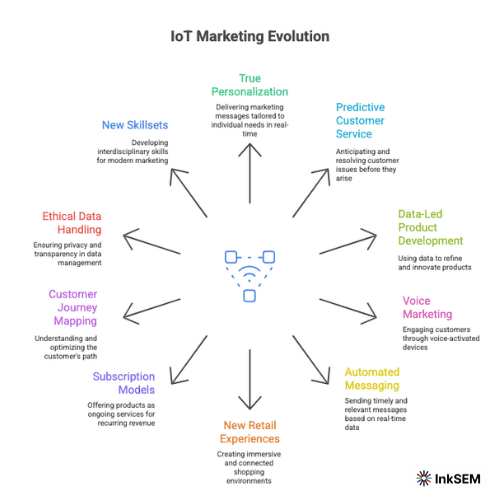10 Ways Your Marketing Strategy Must Evolve with IoT in the Next Decade

The Internet of Things (IoT) is no longer a future concept. It is the new foundation of business, connecting our homes, cars, and workplaces into a seamless network of data. In this environment, traditional marketing is losing its impact.
Your strategy must change to remain competitive. With an estimated 75 billion connected devices online by 2025, adaptation is mandatory. Modern marketing is now defined by automation, personalisation, and real-time customer engagement.
Best 10 Ways Your Marketing Strategy Must Evolve

Achieve True Personalisation
Marketers have always aimed for one-to-one communication. IoT makes it a reality. Instead of relying on past purchases, connected devices provide real-time context from a user’s daily life.
A smart refrigerator can trigger a milk coupon as you leave the office. Your car can suggest a coffee shop during your commute. This level of personalisation requires platforms that process live data to deliver marketing at the precise moment of need. Smooth application development is key to turning this data into a fluid user experience across all devices.
Implement Predictive Customer Service
IoT shifts customer service from a reactive model to a proactive one. Connected devices monitor their health and can act before a problem occurs.
A washing machine can schedule its repair appointment. A printer can order new ink before it runs out. This approach prevents customer frustration and builds lasting loyalty. Marketers must communicate these benefits to reinforce brand trust and build momentum.
Use Data-Led Product Development
IoT produces a strong feedback cycle between the product team and the customer. Data from devices indicates the user’s pain points and reveals new possibilities.
If users are having trouble with thermostat settings, the product can be updated to make the interface easier. Fitness tracker data can create new exercise programs. This cycle of ongoing refinement helps your products align with actual demands.
Also Read: Tips to Improve Small Business Digital Marketing Strategy
Master Voice Marketing
Smart speakers and voice assistants will soon outnumber people. Voice has become a primary marketing channel. Success here requires more than simple keywords. It demands conversational marketing and brand experiences built for voice interaction. Brands without a voice strategy will become invisible.
Deliver Automated, Just-in-Time Messages
What if the smart home senses you are leaving for your work, and it automatically triggers a notification with current traffic updates and a discount for a coffee shop on your route? Sounds handy, doesn’t it? This is just-in-time marketing: relevant, helpful, and integrated into daily life.
Focus on Creating New Retail Experiences
The line between physical and digital retail is almost gone now. Stores are now connected ecosystems that merge a physical presence with digital intelligence.
In-store beacons can send personalised offers. Smart shelves track inventory in real time. This gives retailers deep insight into shopper behaviour and a unified view of the online-to-offline journey. Businesses can accelerate these pilots with an experienced IoT development provider that unifies fragmented proofs of concept into scalable, end-to-end solutions.
Shift to Subscription and Service Models
IoT allows businesses to move past one-time transactions. Products can now be sold as ongoing services. A home security system becomes a monthly subscription.
A car becomes a service package that includes insurance & maintenance. These models create recurring revenue and long-term customer relationships, forcing a re-evaluation of the traditional business model canvas.
Properly Map Out the Customer Journey
The customer journey no longer ends with a purchase. IoT reveals how customers use products long after the sale. As a Marketer, you can observe these usage patterns to refine your strategies.
Retailers can see how customers move through a store and what interactions lead to a decision. This visibility helps resolve issues and personalise the entire journey.
Always Prioritize Ethical + Efficient Data Handling.
With more data comes even greater responsibility. IoT marketing demands that you manage sensitive personal information with care. Transparency is vital. Customers must know what data you are collecting and how you use it. Strong privacy policies and security are no longer optional; they are a core competitive advantage.
Develop New Marketing Skillsets
As a marketer in the current era of AI, you must combine data science, technology, and storytelling to analyse large datasets, work directly with engineers, and build campaigns from the insights. This requires continuous learning and collaboration across departments to deliver a unified customer experience.
Also Read: Highly-Demanded Web Development Trends
Putting IoT into Action: Your Strategic Blueprint
Moving from concept to execution requires a deliberate, structured approach. Vague strategies will fail. Use these steps as a blueprint to build a marketing function that is truly ready for a connected world.
Build a Resilient Foundation
Your ability to act on IoT data is only as good as your technical foundation. Get this right first.
- Smartly Combine Your Data Streams: Don’t just collect data; centralise it. Start by implementing a Customer Data Platform (CDP) or a similar solution that unifies event streams from different devices, apps, and websites.
- Make the Edge vs. Cloud Decision: This isn’t just a technical choice; it’s a strategic one. Use edge computing (processing data on the device itself) for low-latency actions that require immediate response, like sending a personalised offer to a customer’s phone as they enter your store. Use cloud computing for deep analysis and machine learning models that identify long-term trends and predict future customer needs.
- Embrace Predictive Intelligence: Move beyond simple triggers. Use machine learning not just for the “next best action,” but to anticipate needs. Your system should analyse usage patterns to predict when a customer might need an upgrade, require support, or be at risk of churn, allowing you to intervene proactively.
- Design for Radical Transparency: A simple opt-out isn’t enough. Build a clear consent framework and a user-friendly privacy dashboard. Give your customers granular control to see exactly what data you are collecting and manage their permissions.
Rethink Your Team and Processes
The old departmental silos are a liability in the age of IoT. You must build integrated, agile teams.
- Form an “IoT Growth Pod”: Create permanent, cross-functional teams that include experts from marketing, product engineering, data science, and legal. Marketing’s job is to define the customer journey and the “moment of need.” Engineering’s job is to make the technology seamless. Data science uncovers the insights. Legal ensures you operate ethically and securely.
- Adopt an Iterative Mindset: IoT marketing isn’t about “launch and leave” campaigns. It’s a continuous cycle of improvement. Prepare your teams to ship rapid firmware and software updates based on real-world usage data. Your marketing strategy must be as dynamic as the software that powers your products.
- Vet Your Partners Rigorously: If you don’t build your own hardware, partner with specialists who prioritise secure-by-design principles. Before committing to a large-scale rollout, validate that their sensors, connectivity, and security protocols are robust enough to protect your customers and your brand. An experienced embedded hardware design partner ensures that devices are engineered securely from the ground up, enabling reliability and trust.
Start Measuring the Right Stuff
The data from connected devices allows you to move beyond vanity metrics and measure real-world impact.
- Focus on Actionable KPIs: Track Feature Adoption Rate (are customers using the smart features?), Proactive Service Incidents (how many problems did you solve before the customer was even aware of them?), and Consumable/Subscription Attach Rate (how effectively are devices driving recurring revenue?).
- Master IoT-Driven Attribution: Create direct links between device interactions and business outcomes. When a smart printer’s automated ink order is processed, that revenue should be attributed directly to the IoT ecosystem. This allows you to build a clear, undeniable business case for further investment.
Strengthen Governance and Security from Day One
In an IoT world, a security breach isn’t just a data leak; it’s a violation of a customer’s personal space. Your governance must be ironclad.
- Enforce Data Minimisation: Follow this simple but powerful principle: collect only what is essential to deliver a better experience. Do not hoard data you don’t need. This reduces your risk and builds customer trust.
- Implement a Zero-Trust Security Model: Assume any connection could be a threat. Enforce strict security measures like signed firmware (to prevent malicious software takeovers) and least-privilege access for all systems and personnel.
- Maintain an Incident Readiness Plan: Prepare for the worst. Your readiness plan must include clear communication protocols and pre-approved messaging for different scenarios. In a crisis, a swift, honest, and helpful response is crucial to protecting your customers and preserving your brand’s reputation.
Also Read: Implementing an Event-Based Destination Marketing Strategy
Final Thoughts
IoT is redefining marketing today. The ten shifts above provide a blueprint for the next decade. Businesses that adapt now will lead the market. Those clinging to old tactics will fall behind. The future of marketing is connected, data-driven, and deeply personal.
